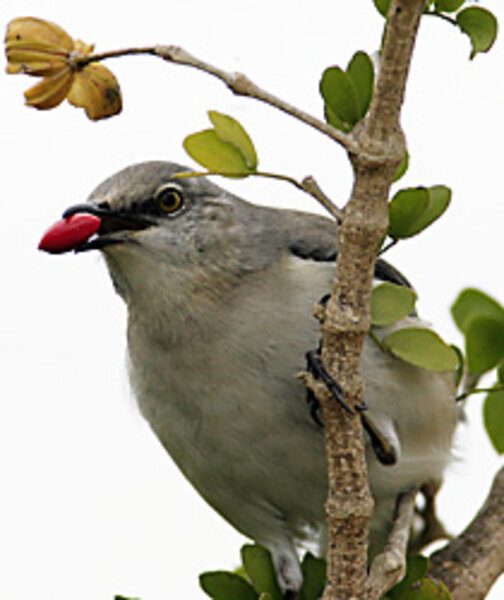Close encounters of the feathery kind
Loading...
Hush, little baby, don't say a word.
Mama's gonna buy you a mockingbird.
If that mockingbird don't sing,
Mama will buy you a diamond ring.
So goes the first verse of an old folk song. It was pretty certain that Mama wouldn't have to buy a diamond ring because mockingbirds outsing all other birds.
A mockingbird is, however, more than just a pretty song.
In their conservative banker's gray, mockingbirds don't look as fierce as crows and hawks do, nor are they flashy and startling like jays. But they can be ferocious in defense of their territory and their young. They shriek, they posture, and they divebomb any perceived menace, be it cat, dog, or human.
As a 7-year-old, I learned to stay away from trees that held mockingbirds in spring and early summer. My father's cat, Tom, was a large, well-muscled creature of enormous dignity, so confident and imperial that when he took his morning stroll, dogs and children moved to the edge of the sidewalk.
One early spring morning as I was walking to school, Tom sauntered down the middle of the sidewalk ahead of me. When he passed under the oak tree, two angry birds flew down at him, attacking with beaks and claws and flailing the unsuspecting cat with their wings. This was the only time Tom ever allowed me to pick him up. Tearfully, I carried him back to Daddy.
From then on during nesting season, Tom and I both crossed the street to avoid the oak tree.
For the past few years, a family of mockingbirds has nested in the magnolia tree on the north side of our house. It's a sure sign of spring when the cats, Friday and Sally, abandon the kitchen window – where they can watch the cardinals and wrens that winter in the hedge – to go to the sitting room, where they can keep an eye on the magnolia tree.
The birds usually arrive before it's warm enough to open the windows, so the presence of cats close to their home is not threatening.
The first year the birds nested in the magnolia tree, the cats and birds didn't find one another until it was warm enough to open the window. The mockingbirds, screeching threats and insults, flew at the cats.
The cats, used to the barrier of a screen, kept their cool, switching their tails occasionally. Although the birds soon learned that the screen kept them separated from the cats, their beaks and claws had torn enough holes in the screen that I had to replace it.
Soon the mockingbirds settled into a routine of morning and evening squawking, with studied indifference most of the day. Since the birds that have nested in the magnolia tree for the past two springs haven't tried to attack through the screen, it seems probable that they're the same pair that first arrived three years ago.
It's better than a movie – watching a small, gray bird sitting on the wall three feet from the window that separates him from his enemies. He puffs up his breast, shakes his half-open wings, and struts back and forth on his four-inch platform. Finally, he lectures us as to his martial intent should we decide to challenge him. There's no doubt in my mind that, with help from his mate, this diminutive warrior could defeat both me and the cats.
Once the young are ready to fly, both parents get into the act of daring us to move toward the fledglings. Occasionally Sally, who is younger and more excitable than Friday, will begin to toss her tail in agitation or stand with her forepaws on the screen. This behavior provokes the parent birds to even greater tirades. Sometimes it seems as if the parents deliberately antagonize their feline neighbors just to encourage a grounded young one to head for the lower branches, a sort of "That bogeyman cat will get you if you don't get up there now!"
After the fledglings are on their own, the family joins the small flock that roosts in neighboring oaks and poplars. Like parrots, they mimic the sounds of their environment, and on bright moonlit nights they practice their repertoires of songs copied from other birds. One evening we were treated to a quarter-hour concert that included the clicks and prettee-prettee of a cardinal, the fluting of a robin, the chip of a wren, and the sad cooh-cooh-cooh of a dove. Each repetition of the medley ended with the chirp-chirp of a car-door opener!
For the past few months, Friday and Sally have spent their days lying nose to nose on the windowsill in the kitchen. Monkish little wrens, colorful cardinals, and the occasional chipmunk provide some interest, but like couch potatoes of all stripes, the cats mostly doze. During the pallid days of winter, I watch them as they soak up the thin sunshine from that southern exposure and wonder if they look forward to springtime and the mockingbirds who will bring them to full alert.
Spring must be upon us now. Even though the mockingbirds aren't back in the magnolia tree yet, the cats seem to be expecting them. This week Friday and Sally have muscled aside the potted plants on the windowsill in the den several times a day so they can see the magnolia tree and the wall. I like to think they are anticipating the arrival of their sparring partners and looking forward to helping train a new generation of mockingbirds.





